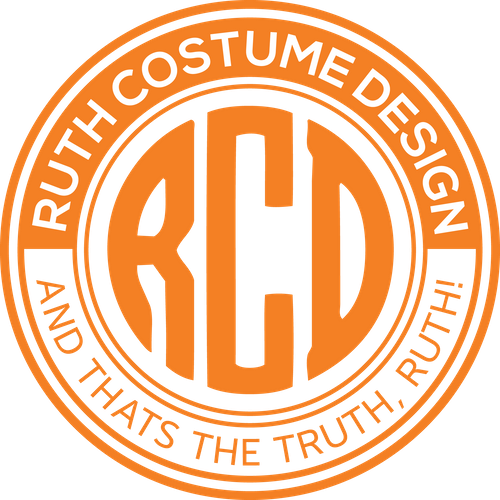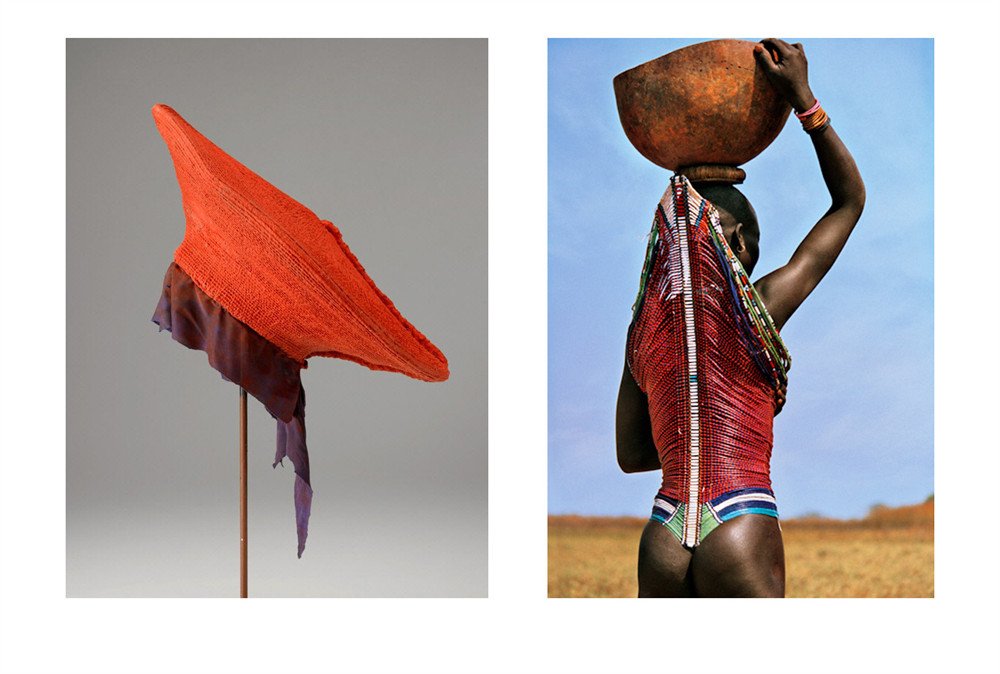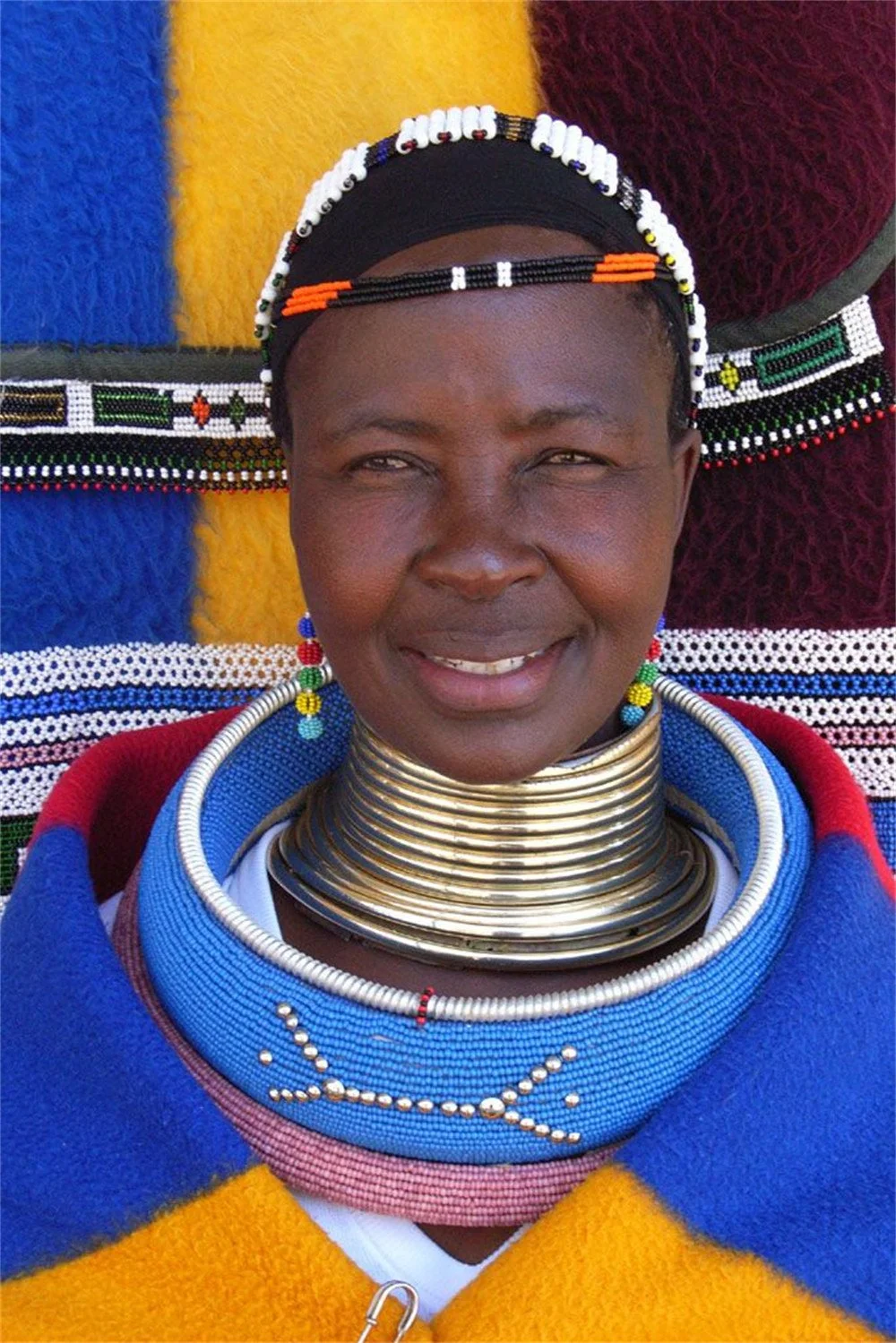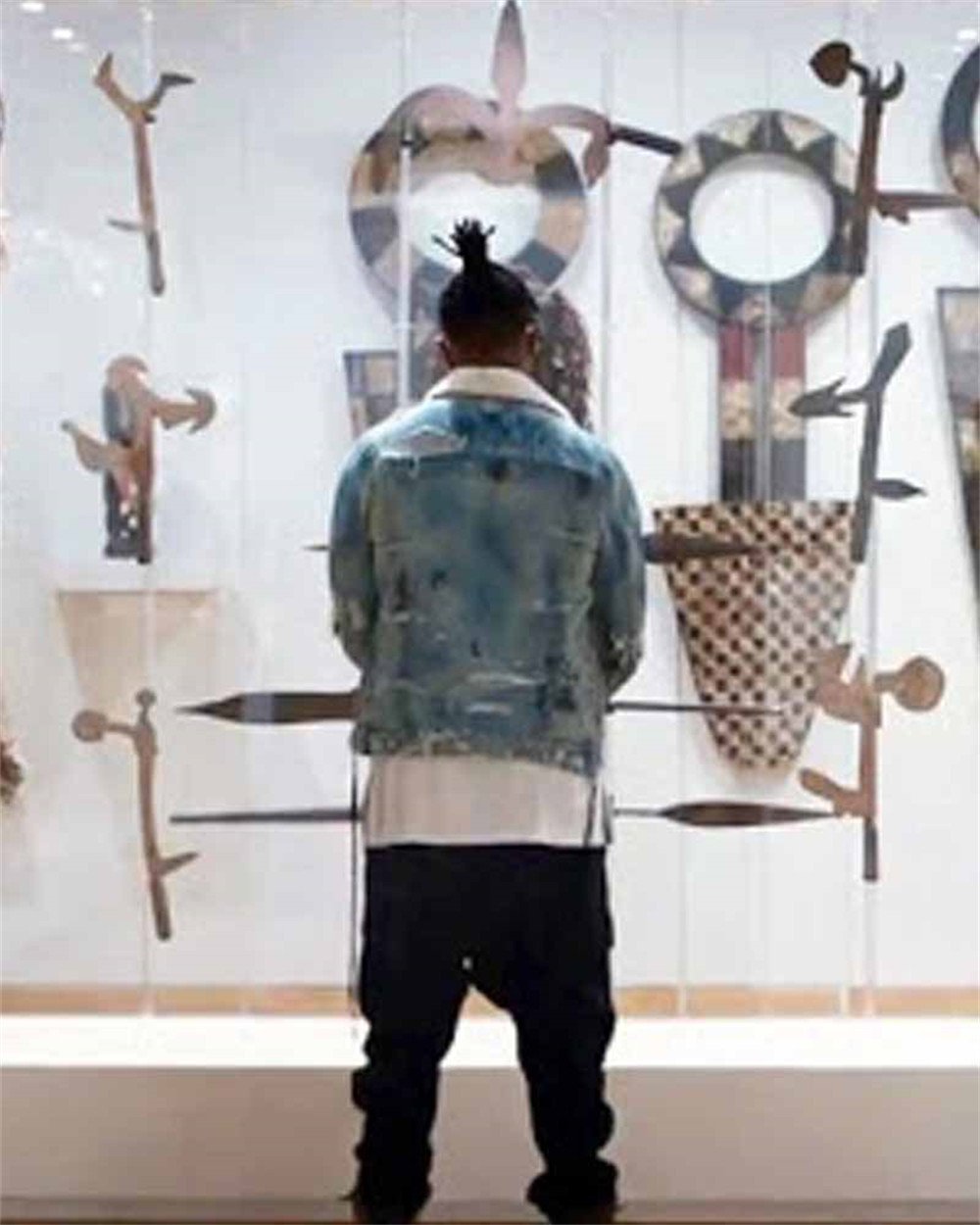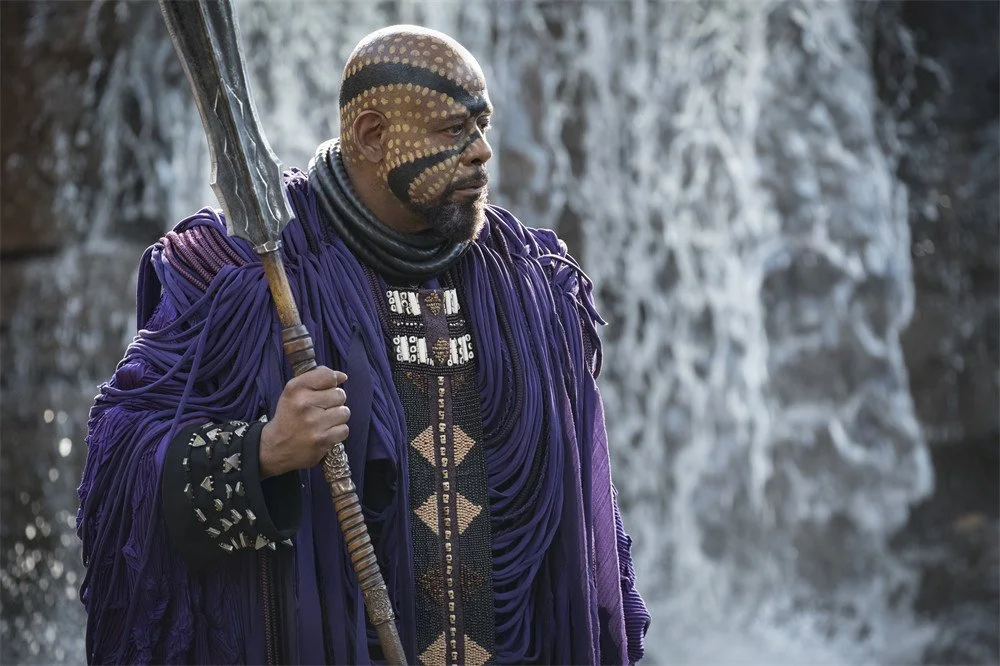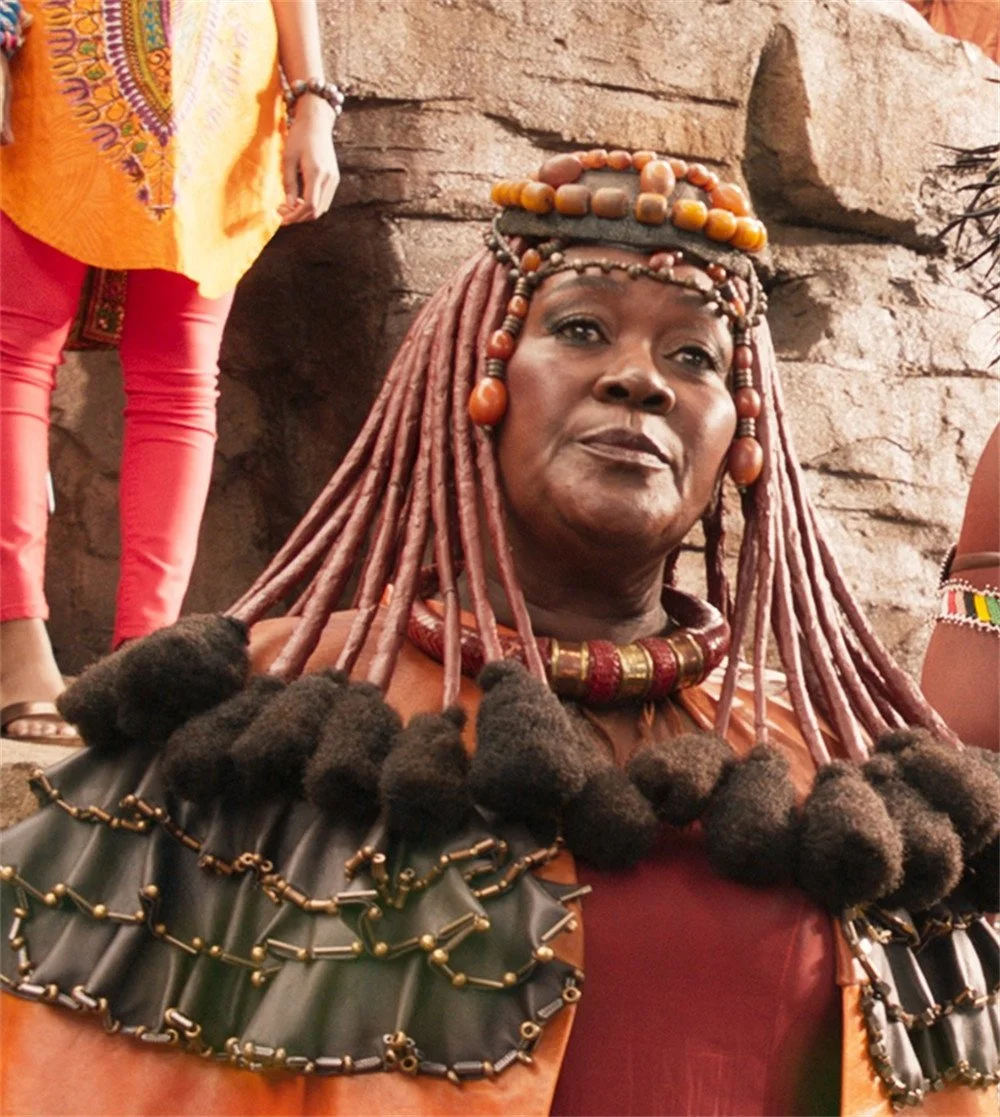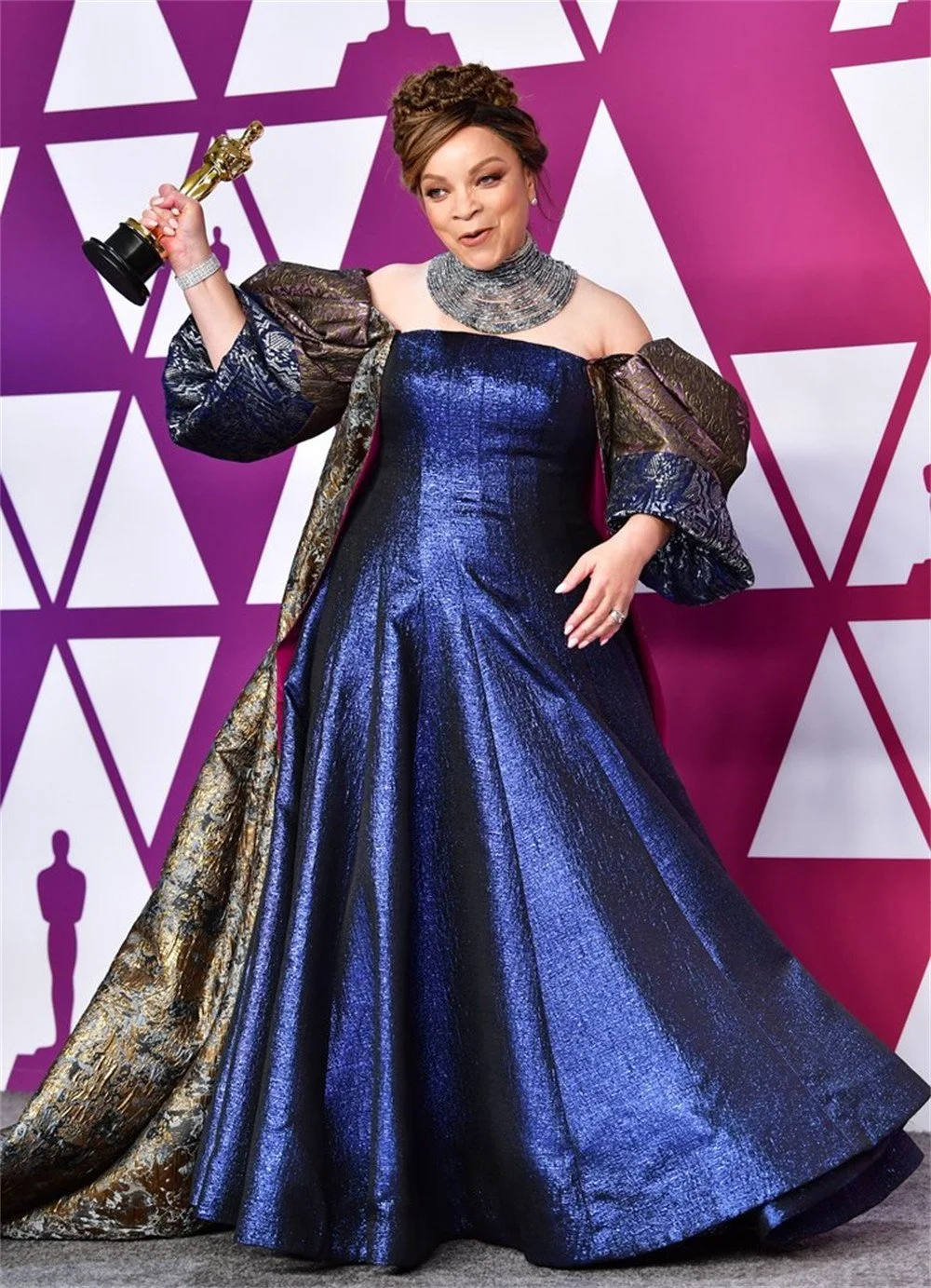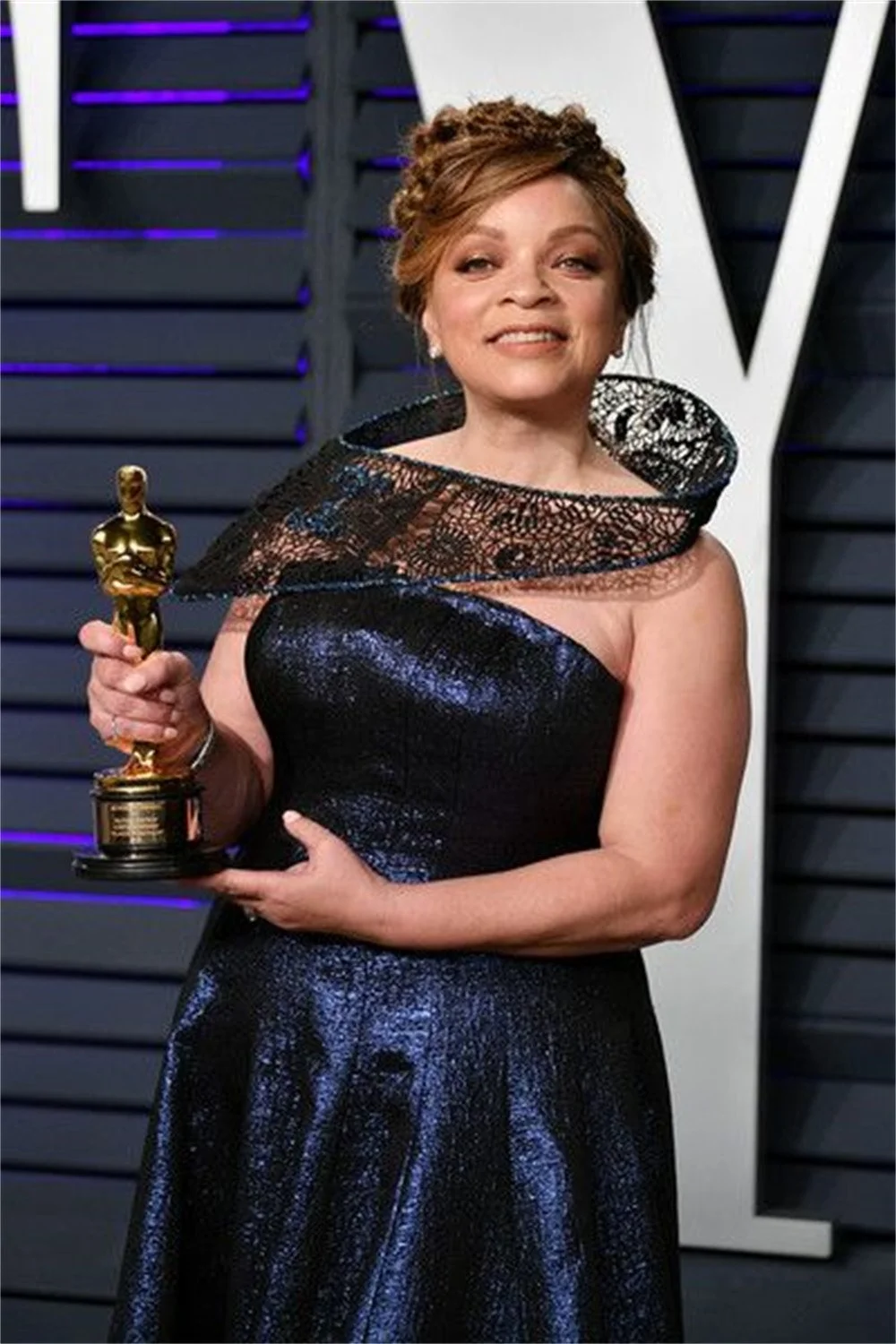Black Panther
Black Panther is based on a comic book character, created by Stan Lee and Jack Kirby, who first appears in the 1966 Marvel comic Fantastic Four. T’Challa, the Black Panther, is king of a nation called Wakanda, a technologically advanced society that produces a powerful metal called Vibranium. The 2018 film is the first to focus solely on T’Challa’s story. Carter collaborated with director Ryan Coogler and production designer Hannah Beachler to create an immersive world drawing on a variety of African cultures for inspiration.
When Carter was in the initial planning stages for the film, she printed out four words and pinned them to her wall: beautiful, positive, forward, and colorful. These adjectives guided her process and can all be used to describe the stunning Black Panther costumes, which merge technology and tradition. Wakanda is a fictional nation within Africa, and Carter based her research on African dress, taking months to familiarize herself with the many different cultural traditions found across the continent. Of this process Carter states, “I think people will be able to contextualize and look at African art and appreciate it so much differently. That’s what we did: We appreciated it, we reimagined it, we took it to another level, another place, and there were inspirations everywhere!”
Carter won the Academy Award for Costume Design for Black Panther.
Film details
Black Panther, 2018
Characters Queen Ramanda and Princess Shuri played by Angela Basset and Letitia Wright.
Materials
Metallic tulle, 3D printed material created by Julia Koerner
Credit
Courtesy of Marvel Studios
Notes
Isicholo, a South African woman’s traditional marriage hat, was the inspiration for Queen Ramonda’s crown and is paired with a dramatic shoulder mantle. Carter worked with the Austrian designer, Julia Koerner, to create the pieces using 3-D printing, integrating technology into the the fabrication of the costumes. PARAGRAPH BREAK When T’Challa is crowned king of Wakanda, Shuri, T’Challa’s sister, has to wear her ceremonial clothing including an intricately beaded corset inspired by the Dinka people. Throughout most of the film Shuri wears modern, bright garments that are appropriate for her age and to her work in the lab. During the solemn ceremony, Shuri interrupts to complain about how uncomfortable her corset is.
Supporting Imagery
Supporting Imagery Notes
Womans Hat (Isicholo), 20th century North Carolina Museum of Art; Dinka woman wearing a traditional corset, photograph by Beckwith & Fisher
Film details
Black Panther, 2018
Character Ayo Dora Milaje played by Florence Kasumba.
Materials
Leather, metal, rubber, beads
Credit
Courtesy of Marvel Studios
Notes
The Dora Miljae are fierce female warriors sworn to protect the king of Wakanda. Their red uniforms were patterned after the dress of the Maasai people from Kenya and their ring collars are reminiscent of those worn by Ndebele women in South Africa. The armor pieces were designed to resemble jewelry, giving the uniforms a more feminine edge. Despite the overall continuity of Dora Miljae, each member wore a tabard that had specific symbolism in the beadwork indicating which tribe they came from.
Supporting Imagery
Supporting Imagery Notes
Ndebele married woman in traditional dress, South Africa. Photo by Walter G. Allgöwer, Getty Images
Film details
Black Panther, 2018
Character W'Kabi played by Daniel Kaluuya.
Materials
Wool, leather
Credit
Courtesy of Marvel Studios
Notes
The blanket worn by W’Kabi is inspired by the Basotho blanket, a garment worn by Sotho people of Lesotho and South Africa. The 200 blankets in the film, produced in Africa, were customized by Carter and her team by screen printing them with Wakandan text and adinkra symbols in silver to represent Vibranium, the precious metal produced in Wakanda. After a camera test, it was decided that the blankets were too thick and not pliable enough. Without enough time to order thinner blankets, Carter’s team had to devise a way to reduce the loft of the blankets. After some experimentation with electric shavers, Carter redesigned the pieces by burning away the natural fibers so the blankets were thinner, but intact.
Supporting Imagery
Supporting Imagery Notes
The blankets used in the film were sourced from Aranda Textile Mills who is the licensed manufactorer of the Basotho Heritage Blanket.
Film details
Black Panther, 2018
Character Killmonger played by Michael B. Jordan.
Materials
Cotton, denim, flannel, faux fur, beads.
Credit
Courtesy of Marvel Studios
Notes
The custom wig was created by recent SCAD alum Kahmani Zeon (B.F.A. Fashion Design, 2020) specifically for this exhbition.
Film details
Black Panther, 2018
Character Zuri played by Forest Whitaker.
Materials
Silk, metal, beads, leather
Credit
Courtesy of Marvel Studios
Notes
Zuri is a shaman and was a trusted advisor to T’Chaka, T’Challa’s father. For the coronation of T’Challa, Zuri wears this ceremonial dress based on an agbada, which is a long robe that Yoruba men of high stature, including priests, wear. The beading on the front tabard is inspired by beadwork of the Turkana people. The small, textural tubes of purple silk that hang from the garment were added by Carter, in part, to float in the water giving a magical effect while Zuri conducts the King ceremony.
Film details
Black Panther, 2018
Character Zuri played by Forest Whitaker.
Materials
Silk, metal, beads, leather
Credit
Courtesy of Marvel Studios
Notes
Carter and director Ryan Coogler developed a color palette for each of the tribes and the mining tribe were dressed in reds and oranges. Her reddish-colored wig is inspired by the Himbe tribe of Namibia and is made by applying red ochre and shea butter to the dreadlocks.
Supporting Imagery
Film details
Black Panther, 2018
Character Nakia played by Lupita Nyong'o.
Materials
Beads, leather, feathers, shells, metal
Credit
Courtesy of Marvel Studios
Notes
Nakia wears this traditional look to the coronation of T’Challa at Warrior Falls. The green colors represent her tribe, the River Tribe, which was inspired by elements of the dress of the Suri people of southwestern Ethiopia. The harness she wears is decorated with puka shells that signify her wealth.
Film details
Black Panther, 2018
Character M'Baku played by Winston Duke.
Materials
Leather, plastic, faux fur, dried grass
Credit
Courtesy of Marvel Studios
Notes
M’Baku is the leader of the Jabari Tribe, a group of outliers living in the mountains that oppose the technology-driven Wakandan life. His dress reflects this rejection; he wears simple garments made with wood, straw, and animal skins. Carter was inspired by the Dogon tribe indigenous to the central plateau region of Mali. The Dogon people are known for their wooden ceremonial sculptures and for their early and advanced knowledge of astronomy.
Film details
Black Panther, 2018
Character T'Challa played by Chadwick Boseman.
Materials
Synthetic, metal
Credit
Courtesy of Marvel Studios
Notes
Carter often discusses the importance of detail in film costume. For the Black Panther suit, her focus was on the texture which she wanted to use to visually connect him with Africa. Carter decided to use a repeating triangular pattern as the triangle represents the sacred geometry of Africa. Carter found that, “when we printed the suit fabric, we did this triangle all over it, and it really did make it have this richer, more storied look. So now he’s not only a superhero, he’s also an African king.”
Materials
Silk
Credit
Courtesy of Ruth E. Carter Archive
Notes
Ruth E. Carter designed this gown to wear to the Academy Awards where she won the Oscar for best costume design for her work in Black Panther. The back of the beaded necklace fearues a horseshoe shaped bead that is engraved with the phrase "2019 Oscar Win" in Wakandan font. The necklace in the glass case was 3-D printed by Julia Koerner, who also printed accessories for the film Black Panther. After the ceremony, Carter wore this necklace to the Vanity Fair Oscar Party hosted by Rahdika Jones.
Supporting Imagery
